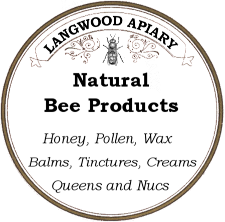 Tops of cells with matured honey are sealed by bees with the construction material of a special composition containing bee wax, propolis, pollen, the secret of the bee salivary glands. This material has good preserving properties and a special aroma, which gives honey comb and honey a unique specificity. It is called “bee wax cappings”. To extract honey from the honeycombs, the beekeeper cuts off the lids of the honeycombs with a sharp, heated knife or opens them with a needle fork.
Tops of cells with matured honey are sealed by bees with the construction material of a special composition containing bee wax, propolis, pollen, the secret of the bee salivary glands. This material has good preserving properties and a special aroma, which gives honey comb and honey a unique specificity. It is called “bee wax cappings”. To extract honey from the honeycombs, the beekeeper cuts off the lids of the honeycombs with a sharp, heated knife or opens them with a needle fork.
Usually “ bee wax cappings” are collected and melted with bee wax comb. Only some beekeepers save “ bee wax cappings” for therapeutic purposes, most people, including physicians, know almost nothing about the healing properties of “ bee wax cappings”. That is why in the assortment of the traditional bee products we rarely see this unique product with a conglomerate of biologically active substances. “Bee wax cappings” have significant antibacterial and antiviral activity and is useful in the treatment of oral cavity, respiratory tract, paranasal sinuses and bowel diseases. It boosts immunity, which allows it to be used as a preventive measure for colds. It does not contain habituation of pathogens and it does not cause allergies. This is an important advantage over the use of conventional medicines. For therapeutic purposes, “ bee wax cappings” is often used as a chewing agent, which contributes to:
- mechanical cleansing and massage of the gums and oral mucosa;
- disinfection of the oral cavity;
- enhanced salivation;
- improvement of the secretory and motor function of the stomach and intestines;
- normalization of intestinal micro flora in case of dysbacteriosis;
- improvement of metabolic processes in the body;
- improvement of the cardiovascular system;
- improvement of the immunity and resistance to catarrhal diseases.
For therapeutic and prophylactic purposes 1 tablespoon of “bee wax cappings” are chewed 3 times a day for 5-10 minutes. The course of treatment – a month or more. If “ bee wax cappings” are dry then 1 teaspoon of honey should be added to it. After chewing wax can be thrown out or swallowed. Swallowing bee wax is recommended for patients with a tendency to constipation as it improves intestinal motility. With rhinitis and sinusitis chewing “bee wax cappings” is repeated throughout the day every hour for 15 minutes. After improvement is noticed (usually in 1-2 days), continue chewing “bee wax cappings” 1-2 times a day for a few days. Chewing “bee wax cappings” from September to June is especially good for children. It helps to prevent respiratory diseases, flu, exacerbation of chronic painful nasopharynx, para nasal sinuses. Dose – 1 tablespoon of “wax cappings” 2-3 times a day in combination with 1 tablespoon of honey 2-3 times a day (D.S. Jarvis).
Apitherapists are prescribing “bee wax cappings” for the prevention and treatment of hay fever (D.S. Jarvis). In the case of a mild form of pollinosis, it is recommended to start chewing “wax cappings” or honeycombs 1-2 weeks before the flowering of the plant or contact with the allergen. For moderately severe allergies, chew “ bee wax cappings” 5 times a day in the first 2 days, and then 1 tablespoon 3 times a day during the entire adverse period. These measures quickly prevent symptoms such as tearing, nasal congestion, and sore throat.
Due to its greater effectiveness than ordinary honeycomb wax, “bee wax cappings” can be used for therapeutic applications, for example, in treatments of joint pathology and radiculitis.
